Parkinson's Disease: Clinical Analysis of Richard's Case and Treatment
VerifiedAdded on 2020/07/23
|11
|3418
|100
Report
AI Summary
This report presents a comprehensive case study of an 80-year-old man, Richard, diagnosed with Parkinson's disease. The report delves into the disease's causes, which are currently unknown, and its pathophysiology, detailing the disruption of neurons in the basal ganglia and the presence of Lewy bodies. It outlines the investigation and tests conducted, including neurological and physical examinations, blood tests, MRI, PET scans, and CT scans, to diagnose Richard's condition. The clinical manifestations, including tremors, bradykinesia, and muscle rigidity, are discussed, along with the clinical course of the disease, categorized into stages. The report also covers the treatment and care options available, such as Carbidopa-levodopa, Carbidopa-levodopa infusion, and Dopamine agonists, along with nursing interventions. The major nursing concerns and interventions are highlighted to provide holistic care for the patient.

Parkinson’s
Disease
Disease
Paraphrase This Document
Need a fresh take? Get an instant paraphrase of this document with our AI Paraphraser
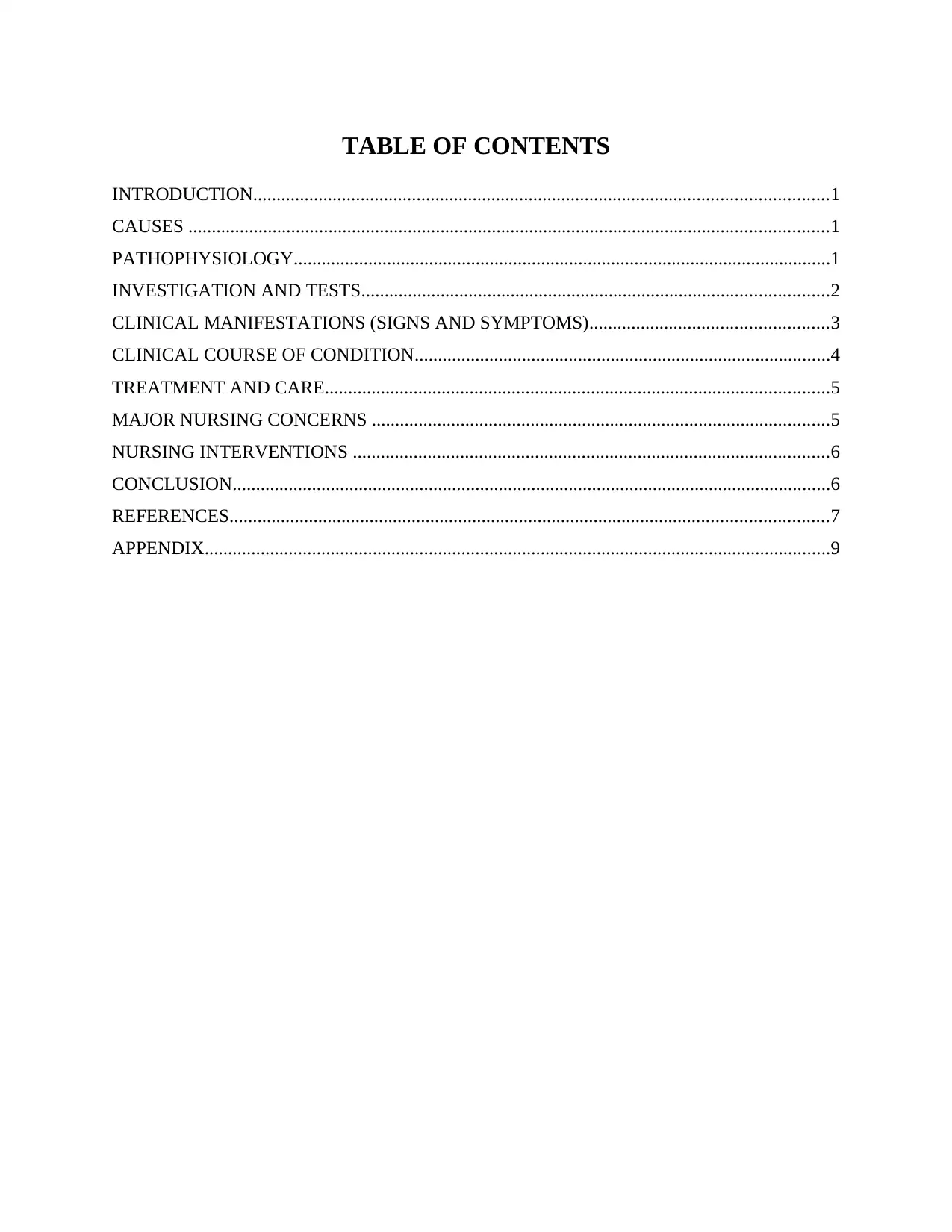
TABLE OF CONTENTS
INTRODUCTION...........................................................................................................................1
CAUSES .........................................................................................................................................1
PATHOPHYSIOLOGY...................................................................................................................1
INVESTIGATION AND TESTS....................................................................................................2
CLINICAL MANIFESTATIONS (SIGNS AND SYMPTOMS)...................................................3
CLINICAL COURSE OF CONDITION.........................................................................................4
TREATMENT AND CARE............................................................................................................5
MAJOR NURSING CONCERNS ..................................................................................................5
NURSING INTERVENTIONS ......................................................................................................6
CONCLUSION................................................................................................................................6
REFERENCES................................................................................................................................7
APPENDIX......................................................................................................................................9
INTRODUCTION...........................................................................................................................1
CAUSES .........................................................................................................................................1
PATHOPHYSIOLOGY...................................................................................................................1
INVESTIGATION AND TESTS....................................................................................................2
CLINICAL MANIFESTATIONS (SIGNS AND SYMPTOMS)...................................................3
CLINICAL COURSE OF CONDITION.........................................................................................4
TREATMENT AND CARE............................................................................................................5
MAJOR NURSING CONCERNS ..................................................................................................5
NURSING INTERVENTIONS ......................................................................................................6
CONCLUSION................................................................................................................................6
REFERENCES................................................................................................................................7
APPENDIX......................................................................................................................................9

INTRODUCTION
This particular assignment is addressing an 80-year-old man Richard, who is suffering
from Parkinson's disease. He lives with his daughter named Zoya and son-in-law Peter.
Parkinson's disease (PD) is a progressive moment disorder which mean that its symptoms keep
on complicating by the passage of time (Allen, Schwarzel and Canning, 2013). It is the second
most common neurological disease that is found in the Australian people after” Dementia”. The
disease effected around 10 million people in whole world with contribution of 10,000 patients
only from Australia. It is estimated that out of 1000 people approximately 4 people are found to
have Parkinson's disease. Every day 32 people in Australia are diagnosed with this disease from
which 20% sufferers are from age below 50 years and 10% are diagnosed among age of above
40 years (Stebbins, G. T. and et.al., 2013). The cause of this disease is still unknown and there is
no particular treatment option available for this disease (Diseases of the nervous system, 2014).
However, treatment options are available for the management of symptoms that arises during this
disease.
CAUSES
The causes of Parkinson disease is unknown. Several factors such as genes, environmental
circumstances lewy bodies and amount of aplha synuclien found in human body causes
Parkinson disease. Specific genes and mutation causes Parkinson's disease which in human
being. Exposure to certain toxins or environmental factors may increase the risk of later
Parkinson's disease, but the risk is relatively small.
PATHOPHYSIOLOGY
The main event that occur in the Parkinson disease is the disruption of the behaviour of
neurons that are present in basal ganglia which generally leads to cell death and effecting the
dopamine secreting neurons in the substantia nigra pars compacts. The second main reason is the
presence of the Lewy bodies (also called alpha synuclien protein) in the neurons. Along with this
loss of neurons many astrocytes also known as star shaped glial cells also died that lead to
increase in number of microglia in substantia nigra (Nalls and et.al., 2014). According to the
non-human Parkinsonism primate models, it was observed that disturbances that occur in the
neurons of basal ganglia results in increased bursting, an augmented synchrony generate the
tendency of loss towards specificity in their appropriate receptive fields. After, this incident the
report of abnormal behaviour of neurons is transmitted to the brainstem, thalamus and cortex and
1
This particular assignment is addressing an 80-year-old man Richard, who is suffering
from Parkinson's disease. He lives with his daughter named Zoya and son-in-law Peter.
Parkinson's disease (PD) is a progressive moment disorder which mean that its symptoms keep
on complicating by the passage of time (Allen, Schwarzel and Canning, 2013). It is the second
most common neurological disease that is found in the Australian people after” Dementia”. The
disease effected around 10 million people in whole world with contribution of 10,000 patients
only from Australia. It is estimated that out of 1000 people approximately 4 people are found to
have Parkinson's disease. Every day 32 people in Australia are diagnosed with this disease from
which 20% sufferers are from age below 50 years and 10% are diagnosed among age of above
40 years (Stebbins, G. T. and et.al., 2013). The cause of this disease is still unknown and there is
no particular treatment option available for this disease (Diseases of the nervous system, 2014).
However, treatment options are available for the management of symptoms that arises during this
disease.
CAUSES
The causes of Parkinson disease is unknown. Several factors such as genes, environmental
circumstances lewy bodies and amount of aplha synuclien found in human body causes
Parkinson disease. Specific genes and mutation causes Parkinson's disease which in human
being. Exposure to certain toxins or environmental factors may increase the risk of later
Parkinson's disease, but the risk is relatively small.
PATHOPHYSIOLOGY
The main event that occur in the Parkinson disease is the disruption of the behaviour of
neurons that are present in basal ganglia which generally leads to cell death and effecting the
dopamine secreting neurons in the substantia nigra pars compacts. The second main reason is the
presence of the Lewy bodies (also called alpha synuclien protein) in the neurons. Along with this
loss of neurons many astrocytes also known as star shaped glial cells also died that lead to
increase in number of microglia in substantia nigra (Nalls and et.al., 2014). According to the
non-human Parkinsonism primate models, it was observed that disturbances that occur in the
neurons of basal ganglia results in increased bursting, an augmented synchrony generate the
tendency of loss towards specificity in their appropriate receptive fields. After, this incident the
report of abnormal behaviour of neurons is transmitted to the brainstem, thalamus and cortex and
1
⊘ This is a preview!⊘
Do you want full access?
Subscribe today to unlock all pages.

Trusted by 1+ million students worldwide
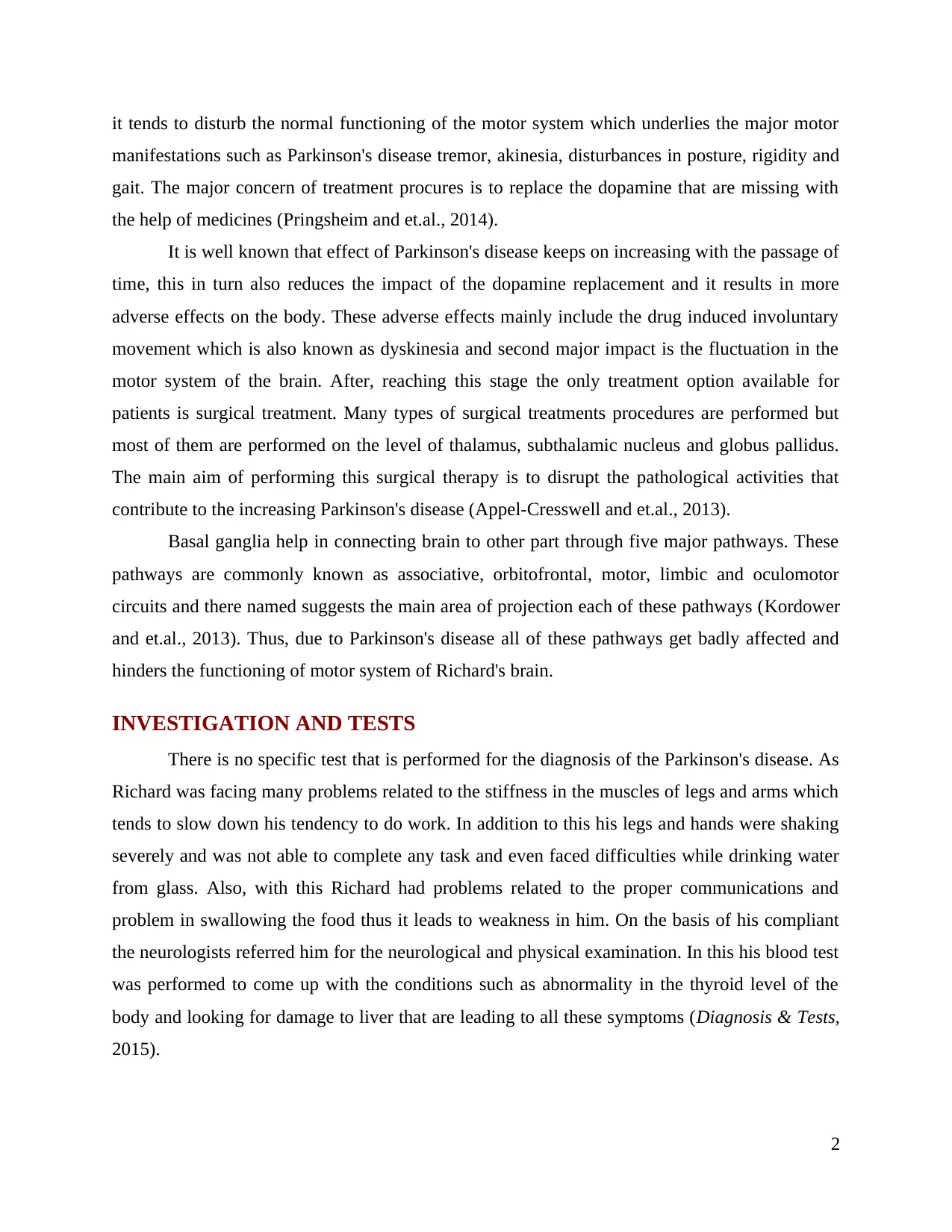
it tends to disturb the normal functioning of the motor system which underlies the major motor
manifestations such as Parkinson's disease tremor, akinesia, disturbances in posture, rigidity and
gait. The major concern of treatment procures is to replace the dopamine that are missing with
the help of medicines (Pringsheim and et.al., 2014).
It is well known that effect of Parkinson's disease keeps on increasing with the passage of
time, this in turn also reduces the impact of the dopamine replacement and it results in more
adverse effects on the body. These adverse effects mainly include the drug induced involuntary
movement which is also known as dyskinesia and second major impact is the fluctuation in the
motor system of the brain. After, reaching this stage the only treatment option available for
patients is surgical treatment. Many types of surgical treatments procedures are performed but
most of them are performed on the level of thalamus, subthalamic nucleus and globus pallidus.
The main aim of performing this surgical therapy is to disrupt the pathological activities that
contribute to the increasing Parkinson's disease (Appel‐Cresswell and et.al., 2013).
Basal ganglia help in connecting brain to other part through five major pathways. These
pathways are commonly known as associative, orbitofrontal, motor, limbic and oculomotor
circuits and there named suggests the main area of projection each of these pathways (Kordower
and et.al., 2013). Thus, due to Parkinson's disease all of these pathways get badly affected and
hinders the functioning of motor system of Richard's brain.
INVESTIGATION AND TESTS
There is no specific test that is performed for the diagnosis of the Parkinson's disease. As
Richard was facing many problems related to the stiffness in the muscles of legs and arms which
tends to slow down his tendency to do work. In addition to this his legs and hands were shaking
severely and was not able to complete any task and even faced difficulties while drinking water
from glass. Also, with this Richard had problems related to the proper communications and
problem in swallowing the food thus it leads to weakness in him. On the basis of his compliant
the neurologists referred him for the neurological and physical examination. In this his blood test
was performed to come up with the conditions such as abnormality in the thyroid level of the
body and looking for damage to liver that are leading to all these symptoms (Diagnosis & Tests,
2015).
2
manifestations such as Parkinson's disease tremor, akinesia, disturbances in posture, rigidity and
gait. The major concern of treatment procures is to replace the dopamine that are missing with
the help of medicines (Pringsheim and et.al., 2014).
It is well known that effect of Parkinson's disease keeps on increasing with the passage of
time, this in turn also reduces the impact of the dopamine replacement and it results in more
adverse effects on the body. These adverse effects mainly include the drug induced involuntary
movement which is also known as dyskinesia and second major impact is the fluctuation in the
motor system of the brain. After, reaching this stage the only treatment option available for
patients is surgical treatment. Many types of surgical treatments procedures are performed but
most of them are performed on the level of thalamus, subthalamic nucleus and globus pallidus.
The main aim of performing this surgical therapy is to disrupt the pathological activities that
contribute to the increasing Parkinson's disease (Appel‐Cresswell and et.al., 2013).
Basal ganglia help in connecting brain to other part through five major pathways. These
pathways are commonly known as associative, orbitofrontal, motor, limbic and oculomotor
circuits and there named suggests the main area of projection each of these pathways (Kordower
and et.al., 2013). Thus, due to Parkinson's disease all of these pathways get badly affected and
hinders the functioning of motor system of Richard's brain.
INVESTIGATION AND TESTS
There is no specific test that is performed for the diagnosis of the Parkinson's disease. As
Richard was facing many problems related to the stiffness in the muscles of legs and arms which
tends to slow down his tendency to do work. In addition to this his legs and hands were shaking
severely and was not able to complete any task and even faced difficulties while drinking water
from glass. Also, with this Richard had problems related to the proper communications and
problem in swallowing the food thus it leads to weakness in him. On the basis of his compliant
the neurologists referred him for the neurological and physical examination. In this his blood test
was performed to come up with the conditions such as abnormality in the thyroid level of the
body and looking for damage to liver that are leading to all these symptoms (Diagnosis & Tests,
2015).
2
Paraphrase This Document
Need a fresh take? Get an instant paraphrase of this document with our AI Paraphraser
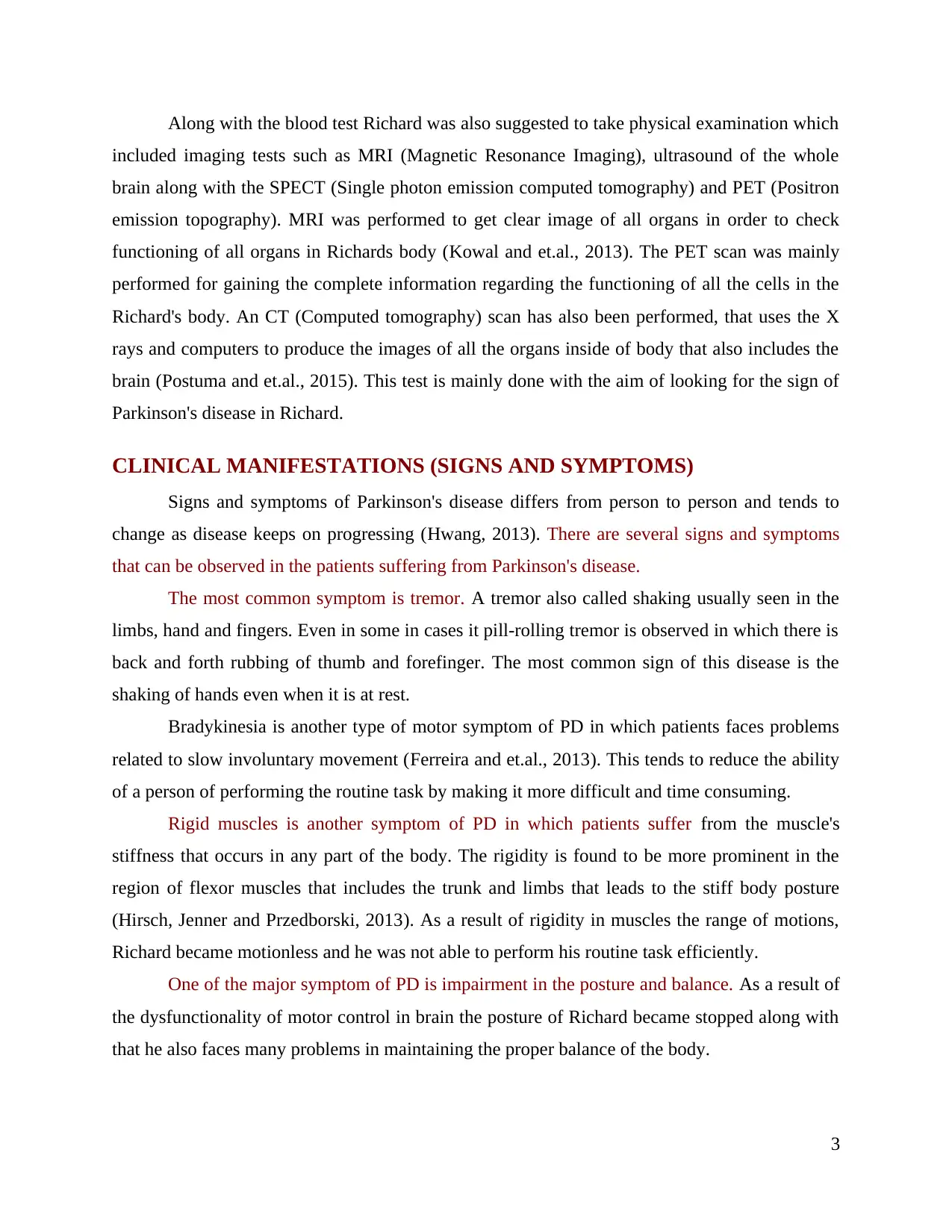
Along with the blood test Richard was also suggested to take physical examination which
included imaging tests such as MRI (Magnetic Resonance Imaging), ultrasound of the whole
brain along with the SPECT (Single photon emission computed tomography) and PET (Positron
emission topography). MRI was performed to get clear image of all organs in order to check
functioning of all organs in Richards body (Kowal and et.al., 2013). The PET scan was mainly
performed for gaining the complete information regarding the functioning of all the cells in the
Richard's body. An CT (Computed tomography) scan has also been performed, that uses the X
rays and computers to produce the images of all the organs inside of body that also includes the
brain (Postuma and et.al., 2015). This test is mainly done with the aim of looking for the sign of
Parkinson's disease in Richard.
CLINICAL MANIFESTATIONS (SIGNS AND SYMPTOMS)
Signs and symptoms of Parkinson's disease differs from person to person and tends to
change as disease keeps on progressing (Hwang, 2013). There are several signs and symptoms
that can be observed in the patients suffering from Parkinson's disease.
The most common symptom is tremor. A tremor also called shaking usually seen in the
limbs, hand and fingers. Even in some in cases it pill-rolling tremor is observed in which there is
back and forth rubbing of thumb and forefinger. The most common sign of this disease is the
shaking of hands even when it is at rest.
Bradykinesia is another type of motor symptom of PD in which patients faces problems
related to slow involuntary movement (Ferreira and et.al., 2013). This tends to reduce the ability
of a person of performing the routine task by making it more difficult and time consuming.
Rigid muscles is another symptom of PD in which patients suffer from the muscle's
stiffness that occurs in any part of the body. The rigidity is found to be more prominent in the
region of flexor muscles that includes the trunk and limbs that leads to the stiff body posture
(Hirsch, Jenner and Przedborski, 2013). As a result of rigidity in muscles the range of motions,
Richard became motionless and he was not able to perform his routine task efficiently.
One of the major symptom of PD is impairment in the posture and balance. As a result of
the dysfunctionality of motor control in brain the posture of Richard became stopped along with
that he also faces many problems in maintaining the proper balance of the body.
3
included imaging tests such as MRI (Magnetic Resonance Imaging), ultrasound of the whole
brain along with the SPECT (Single photon emission computed tomography) and PET (Positron
emission topography). MRI was performed to get clear image of all organs in order to check
functioning of all organs in Richards body (Kowal and et.al., 2013). The PET scan was mainly
performed for gaining the complete information regarding the functioning of all the cells in the
Richard's body. An CT (Computed tomography) scan has also been performed, that uses the X
rays and computers to produce the images of all the organs inside of body that also includes the
brain (Postuma and et.al., 2015). This test is mainly done with the aim of looking for the sign of
Parkinson's disease in Richard.
CLINICAL MANIFESTATIONS (SIGNS AND SYMPTOMS)
Signs and symptoms of Parkinson's disease differs from person to person and tends to
change as disease keeps on progressing (Hwang, 2013). There are several signs and symptoms
that can be observed in the patients suffering from Parkinson's disease.
The most common symptom is tremor. A tremor also called shaking usually seen in the
limbs, hand and fingers. Even in some in cases it pill-rolling tremor is observed in which there is
back and forth rubbing of thumb and forefinger. The most common sign of this disease is the
shaking of hands even when it is at rest.
Bradykinesia is another type of motor symptom of PD in which patients faces problems
related to slow involuntary movement (Ferreira and et.al., 2013). This tends to reduce the ability
of a person of performing the routine task by making it more difficult and time consuming.
Rigid muscles is another symptom of PD in which patients suffer from the muscle's
stiffness that occurs in any part of the body. The rigidity is found to be more prominent in the
region of flexor muscles that includes the trunk and limbs that leads to the stiff body posture
(Hirsch, Jenner and Przedborski, 2013). As a result of rigidity in muscles the range of motions,
Richard became motionless and he was not able to perform his routine task efficiently.
One of the major symptom of PD is impairment in the posture and balance. As a result of
the dysfunctionality of motor control in brain the posture of Richard became stopped along with
that he also faces many problems in maintaining the proper balance of the body.
3
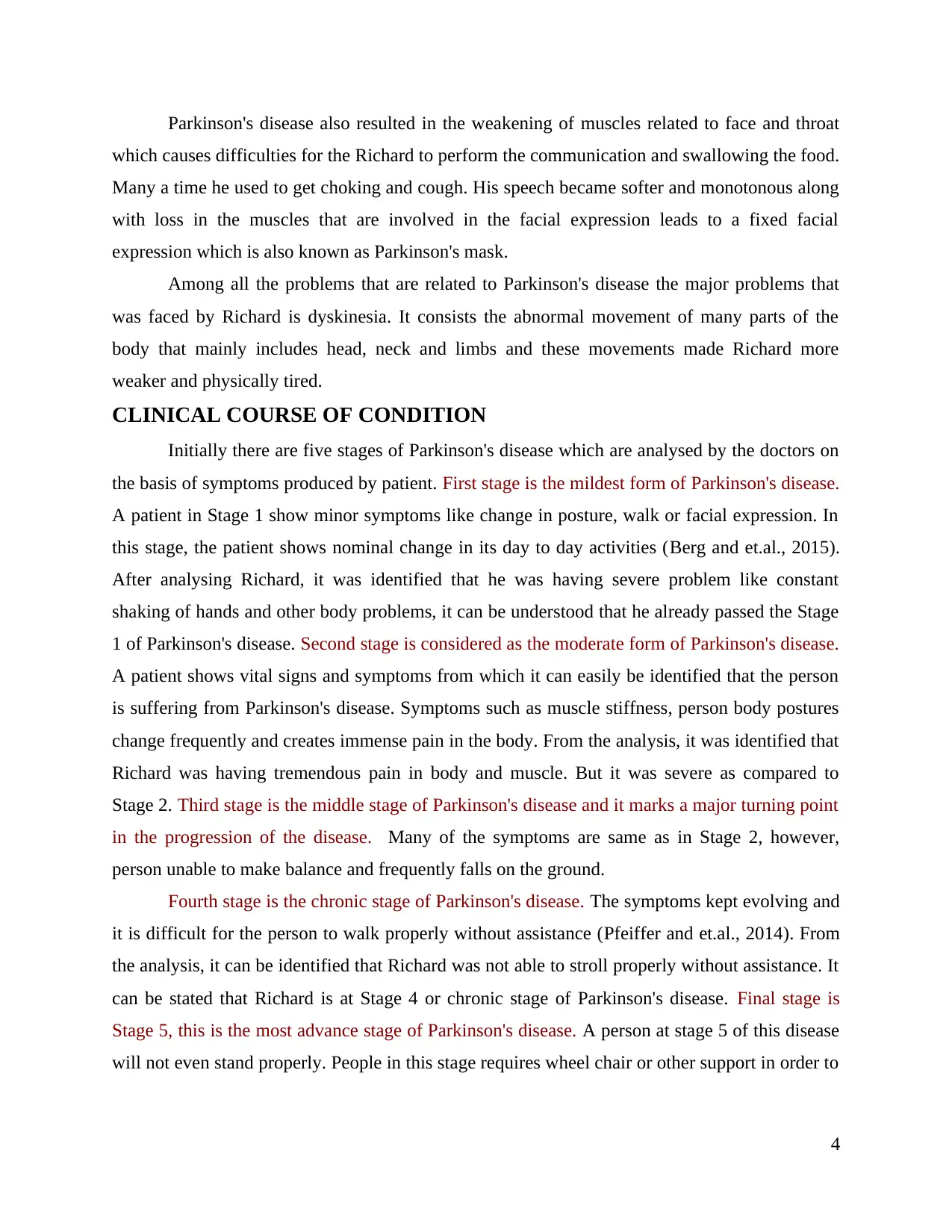
Parkinson's disease also resulted in the weakening of muscles related to face and throat
which causes difficulties for the Richard to perform the communication and swallowing the food.
Many a time he used to get choking and cough. His speech became softer and monotonous along
with loss in the muscles that are involved in the facial expression leads to a fixed facial
expression which is also known as Parkinson's mask.
Among all the problems that are related to Parkinson's disease the major problems that
was faced by Richard is dyskinesia. It consists the abnormal movement of many parts of the
body that mainly includes head, neck and limbs and these movements made Richard more
weaker and physically tired.
CLINICAL COURSE OF CONDITION
Initially there are five stages of Parkinson's disease which are analysed by the doctors on
the basis of symptoms produced by patient. First stage is the mildest form of Parkinson's disease.
A patient in Stage 1 show minor symptoms like change in posture, walk or facial expression. In
this stage, the patient shows nominal change in its day to day activities (Berg and et.al., 2015).
After analysing Richard, it was identified that he was having severe problem like constant
shaking of hands and other body problems, it can be understood that he already passed the Stage
1 of Parkinson's disease. Second stage is considered as the moderate form of Parkinson's disease.
A patient shows vital signs and symptoms from which it can easily be identified that the person
is suffering from Parkinson's disease. Symptoms such as muscle stiffness, person body postures
change frequently and creates immense pain in the body. From the analysis, it was identified that
Richard was having tremendous pain in body and muscle. But it was severe as compared to
Stage 2. Third stage is the middle stage of Parkinson's disease and it marks a major turning point
in the progression of the disease. Many of the symptoms are same as in Stage 2, however,
person unable to make balance and frequently falls on the ground.
Fourth stage is the chronic stage of Parkinson's disease. The symptoms kept evolving and
it is difficult for the person to walk properly without assistance (Pfeiffer and et.al., 2014). From
the analysis, it can be identified that Richard was not able to stroll properly without assistance. It
can be stated that Richard is at Stage 4 or chronic stage of Parkinson's disease. Final stage is
Stage 5, this is the most advance stage of Parkinson's disease. A person at stage 5 of this disease
will not even stand properly. People in this stage requires wheel chair or other support in order to
4
which causes difficulties for the Richard to perform the communication and swallowing the food.
Many a time he used to get choking and cough. His speech became softer and monotonous along
with loss in the muscles that are involved in the facial expression leads to a fixed facial
expression which is also known as Parkinson's mask.
Among all the problems that are related to Parkinson's disease the major problems that
was faced by Richard is dyskinesia. It consists the abnormal movement of many parts of the
body that mainly includes head, neck and limbs and these movements made Richard more
weaker and physically tired.
CLINICAL COURSE OF CONDITION
Initially there are five stages of Parkinson's disease which are analysed by the doctors on
the basis of symptoms produced by patient. First stage is the mildest form of Parkinson's disease.
A patient in Stage 1 show minor symptoms like change in posture, walk or facial expression. In
this stage, the patient shows nominal change in its day to day activities (Berg and et.al., 2015).
After analysing Richard, it was identified that he was having severe problem like constant
shaking of hands and other body problems, it can be understood that he already passed the Stage
1 of Parkinson's disease. Second stage is considered as the moderate form of Parkinson's disease.
A patient shows vital signs and symptoms from which it can easily be identified that the person
is suffering from Parkinson's disease. Symptoms such as muscle stiffness, person body postures
change frequently and creates immense pain in the body. From the analysis, it was identified that
Richard was having tremendous pain in body and muscle. But it was severe as compared to
Stage 2. Third stage is the middle stage of Parkinson's disease and it marks a major turning point
in the progression of the disease. Many of the symptoms are same as in Stage 2, however,
person unable to make balance and frequently falls on the ground.
Fourth stage is the chronic stage of Parkinson's disease. The symptoms kept evolving and
it is difficult for the person to walk properly without assistance (Pfeiffer and et.al., 2014). From
the analysis, it can be identified that Richard was not able to stroll properly without assistance. It
can be stated that Richard is at Stage 4 or chronic stage of Parkinson's disease. Final stage is
Stage 5, this is the most advance stage of Parkinson's disease. A person at stage 5 of this disease
will not even stand properly. People in this stage requires wheel chair or other support in order to
4
⊘ This is a preview!⊘
Do you want full access?
Subscribe today to unlock all pages.

Trusted by 1+ million students worldwide
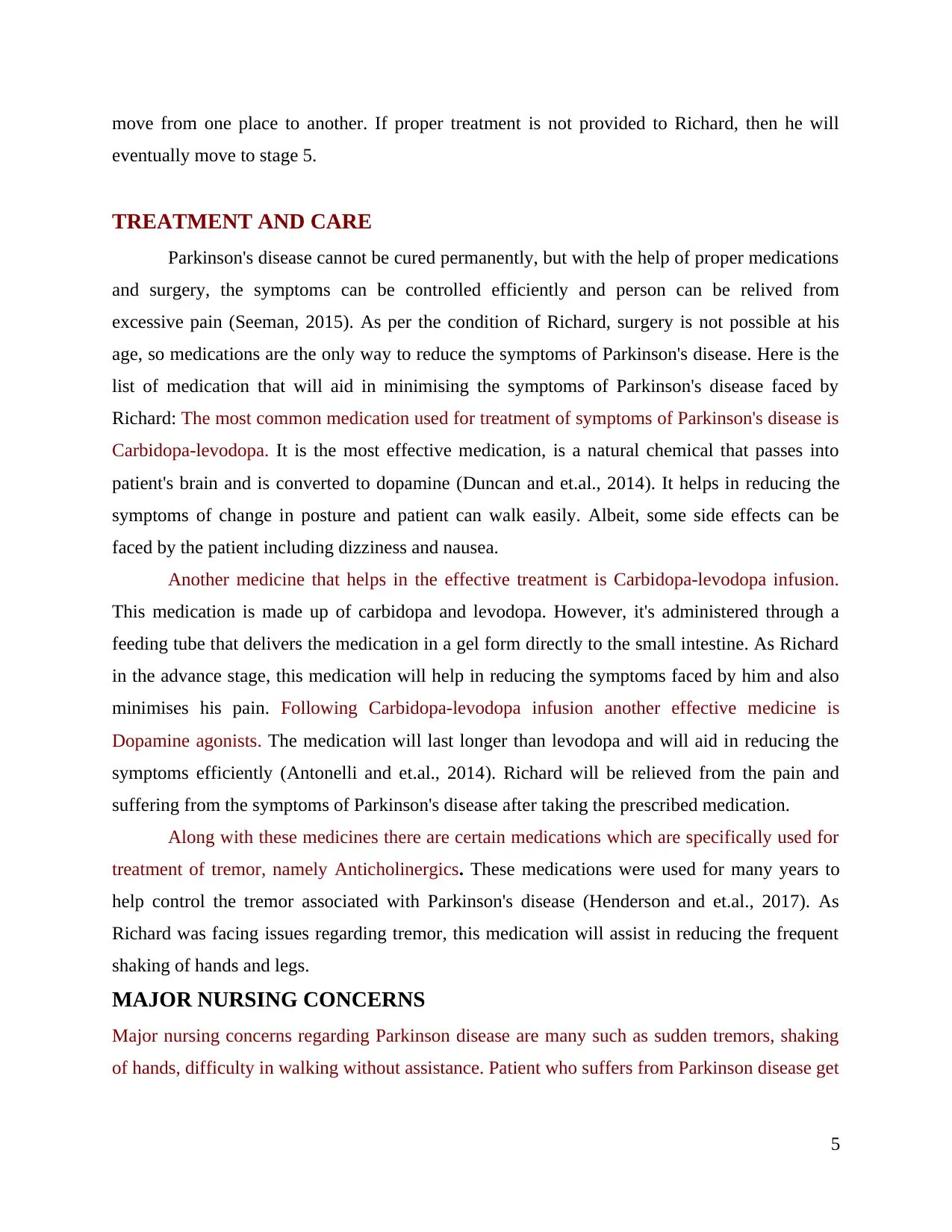
move from one place to another. If proper treatment is not provided to Richard, then he will
eventually move to stage 5.
TREATMENT AND CARE
Parkinson's disease cannot be cured permanently, but with the help of proper medications
and surgery, the symptoms can be controlled efficiently and person can be relived from
excessive pain (Seeman, 2015). As per the condition of Richard, surgery is not possible at his
age, so medications are the only way to reduce the symptoms of Parkinson's disease. Here is the
list of medication that will aid in minimising the symptoms of Parkinson's disease faced by
Richard: The most common medication used for treatment of symptoms of Parkinson's disease is
Carbidopa-levodopa. It is the most effective medication, is a natural chemical that passes into
patient's brain and is converted to dopamine (Duncan and et.al., 2014). It helps in reducing the
symptoms of change in posture and patient can walk easily. Albeit, some side effects can be
faced by the patient including dizziness and nausea.
Another medicine that helps in the effective treatment is Carbidopa-levodopa infusion.
This medication is made up of carbidopa and levodopa. However, it's administered through a
feeding tube that delivers the medication in a gel form directly to the small intestine. As Richard
in the advance stage, this medication will help in reducing the symptoms faced by him and also
minimises his pain. Following Carbidopa-levodopa infusion another effective medicine is
Dopamine agonists. The medication will last longer than levodopa and will aid in reducing the
symptoms efficiently (Antonelli and et.al., 2014). Richard will be relieved from the pain and
suffering from the symptoms of Parkinson's disease after taking the prescribed medication.
Along with these medicines there are certain medications which are specifically used for
treatment of tremor, namely Anticholinergics. These medications were used for many years to
help control the tremor associated with Parkinson's disease (Henderson and et.al., 2017). As
Richard was facing issues regarding tremor, this medication will assist in reducing the frequent
shaking of hands and legs.
MAJOR NURSING CONCERNS
Major nursing concerns regarding Parkinson disease are many such as sudden tremors, shaking
of hands, difficulty in walking without assistance. Patient who suffers from Parkinson disease get
5
eventually move to stage 5.
TREATMENT AND CARE
Parkinson's disease cannot be cured permanently, but with the help of proper medications
and surgery, the symptoms can be controlled efficiently and person can be relived from
excessive pain (Seeman, 2015). As per the condition of Richard, surgery is not possible at his
age, so medications are the only way to reduce the symptoms of Parkinson's disease. Here is the
list of medication that will aid in minimising the symptoms of Parkinson's disease faced by
Richard: The most common medication used for treatment of symptoms of Parkinson's disease is
Carbidopa-levodopa. It is the most effective medication, is a natural chemical that passes into
patient's brain and is converted to dopamine (Duncan and et.al., 2014). It helps in reducing the
symptoms of change in posture and patient can walk easily. Albeit, some side effects can be
faced by the patient including dizziness and nausea.
Another medicine that helps in the effective treatment is Carbidopa-levodopa infusion.
This medication is made up of carbidopa and levodopa. However, it's administered through a
feeding tube that delivers the medication in a gel form directly to the small intestine. As Richard
in the advance stage, this medication will help in reducing the symptoms faced by him and also
minimises his pain. Following Carbidopa-levodopa infusion another effective medicine is
Dopamine agonists. The medication will last longer than levodopa and will aid in reducing the
symptoms efficiently (Antonelli and et.al., 2014). Richard will be relieved from the pain and
suffering from the symptoms of Parkinson's disease after taking the prescribed medication.
Along with these medicines there are certain medications which are specifically used for
treatment of tremor, namely Anticholinergics. These medications were used for many years to
help control the tremor associated with Parkinson's disease (Henderson and et.al., 2017). As
Richard was facing issues regarding tremor, this medication will assist in reducing the frequent
shaking of hands and legs.
MAJOR NURSING CONCERNS
Major nursing concerns regarding Parkinson disease are many such as sudden tremors, shaking
of hands, difficulty in walking without assistance. Patient who suffers from Parkinson disease get
5
Paraphrase This Document
Need a fresh take? Get an instant paraphrase of this document with our AI Paraphraser

these symptoms frequently. Thus, it implies that these are some major nursing concerns which
are to be considered while treating Parkinson disease.
NURSING INTERVENTIONS
Patient should go for daily basis in order to reduce the symptoms of Parkinson disease. They
must be provided with oral care in order to eradicate the suffering they faced due to Parkinson
disease. Use of proper medication and treatment in order to eliminate the issues faced by the
patients of Parkinson disease.
CONCLUSION
From above discussion of the prevalence of Parkinson's disease in Richard, it can be
concluded that this disease is not curable till date and keeps on progressing with the passage of
time. The treatment options are only available for proper management of symptoms that arises
during the course of this disease (Stebbins and et.al., 2013). Along with that it can also be
inferred that no specific tests are available for appropriate diagnosis of Parkinson's disease and
tests are generally performed on the basis of the symptoms that are visible and complications that
are faced by particular patients. On the basis of the tests that were performed on Richard
concludes that he is suffering from the stage 4 of Parkinson's disease. There are medical
interventions available to deal with the aroused complication in Richard such as carbidopa-
levadopa, dopamine agonists and anticholinergic. But the most advance medical intervention
found till date is carbidopa-levadopa infusion, which is administered by using the feeding tube
(Burke and O'malley, 2013). Thus, at the end it can be concluded a good deal of research is still
in progress for finding the appropriate intervention of this disease.
6
are to be considered while treating Parkinson disease.
NURSING INTERVENTIONS
Patient should go for daily basis in order to reduce the symptoms of Parkinson disease. They
must be provided with oral care in order to eradicate the suffering they faced due to Parkinson
disease. Use of proper medication and treatment in order to eliminate the issues faced by the
patients of Parkinson disease.
CONCLUSION
From above discussion of the prevalence of Parkinson's disease in Richard, it can be
concluded that this disease is not curable till date and keeps on progressing with the passage of
time. The treatment options are only available for proper management of symptoms that arises
during the course of this disease (Stebbins and et.al., 2013). Along with that it can also be
inferred that no specific tests are available for appropriate diagnosis of Parkinson's disease and
tests are generally performed on the basis of the symptoms that are visible and complications that
are faced by particular patients. On the basis of the tests that were performed on Richard
concludes that he is suffering from the stage 4 of Parkinson's disease. There are medical
interventions available to deal with the aroused complication in Richard such as carbidopa-
levadopa, dopamine agonists and anticholinergic. But the most advance medical intervention
found till date is carbidopa-levadopa infusion, which is administered by using the feeding tube
(Burke and O'malley, 2013). Thus, at the end it can be concluded a good deal of research is still
in progress for finding the appropriate intervention of this disease.
6

REFERENCES
Books and journals
Allen, N. E., Schwarzel, A. K. and Canning, C. G., 2013. Recurrent falls in Parkinson’s disease:
a systematic review. Parkinson’s disease, 2013.
Antonelli, F. and et.al., 2014. Dopamine‐agonists and impulsivity in Parkinson's disease:
Impulsive choices vs. impulsive actions. Human brain mapping. 35(6). pp.2499-2506.
Appel‐Cresswell, S. and et.al., 2013. Alpha‐synuclein p. H50Q, a novel pathogenic mutation for
Parkinson's disease. Movement disorders. 28(6). pp.811-813.
Berg, D. and et.al., 2015. MDS research criteria for prodromal Parkinson's disease. Movement
Disorders. 30(12). pp.1600-1611.
Burke, R. E. and O'malley, K., 2013. Axon degeneration in Parkinson's disease. Experimental
neurology. 246. pp.72-83.
Duncan, G. W. and et.al., 2014. Health‐related quality of life in early Parkinson's disease: The
impact of nonmotor symptoms. Movement disorders. 29(2). pp.195-202.
Ferreira, J. J. and et.al., 2013. Summary of the recommendations of the EFNS/MDS‐ES review
on therapeutic management of Parkinson's disease. European journal of neurology. 20(1).
pp.5-15.
Henderson, E.J. and et.al., 2017. 158 Does The Anticholinergic Burden Of Drugs Predict
Outcomes In People With Parkinson's Disease With A History Of A Fall?. Age and
Ageing. 46(suppl_1). pp. i44-i44.
Hirsch, E. C., Jenner, P. and Przedborski, S., 2013. Pathogenesis of Parkinson's
disease. Movement Disorders. 28(1). pp.24-30.
Hwang, O., 2013. Role of oxidative stress in Parkinson's disease. Experimental
neurobiology. 22(1). pp.11-17.
Kordower, J. H. and et.al., 2013. Disease duration and the integrity of the nigrostriatal system in
Parkinson’s disease. Brain. 136(8). pp.2419-2431.
Kowal, S. L. and et.al., 2013. The current and projected economic burden of Parkinson's disease
in the United States. Movement Disorders. 28(3). pp.311-318.
Nalls, M. A. and et.al., 2014. Large-scale meta-analysis of genome-wide association data
identifies six new risk loci for Parkinson's disease. Nature genetics. 46(9). pp.989-993.
Pfeiffer, H. C. V. and et.al., 2014. Cognitive impairment in early‐stage non‐demented
Parkinson's disease patients. Acta Neurologica Scandinavica. 129(5). pp.307-318.
7
Books and journals
Allen, N. E., Schwarzel, A. K. and Canning, C. G., 2013. Recurrent falls in Parkinson’s disease:
a systematic review. Parkinson’s disease, 2013.
Antonelli, F. and et.al., 2014. Dopamine‐agonists and impulsivity in Parkinson's disease:
Impulsive choices vs. impulsive actions. Human brain mapping. 35(6). pp.2499-2506.
Appel‐Cresswell, S. and et.al., 2013. Alpha‐synuclein p. H50Q, a novel pathogenic mutation for
Parkinson's disease. Movement disorders. 28(6). pp.811-813.
Berg, D. and et.al., 2015. MDS research criteria for prodromal Parkinson's disease. Movement
Disorders. 30(12). pp.1600-1611.
Burke, R. E. and O'malley, K., 2013. Axon degeneration in Parkinson's disease. Experimental
neurology. 246. pp.72-83.
Duncan, G. W. and et.al., 2014. Health‐related quality of life in early Parkinson's disease: The
impact of nonmotor symptoms. Movement disorders. 29(2). pp.195-202.
Ferreira, J. J. and et.al., 2013. Summary of the recommendations of the EFNS/MDS‐ES review
on therapeutic management of Parkinson's disease. European journal of neurology. 20(1).
pp.5-15.
Henderson, E.J. and et.al., 2017. 158 Does The Anticholinergic Burden Of Drugs Predict
Outcomes In People With Parkinson's Disease With A History Of A Fall?. Age and
Ageing. 46(suppl_1). pp. i44-i44.
Hirsch, E. C., Jenner, P. and Przedborski, S., 2013. Pathogenesis of Parkinson's
disease. Movement Disorders. 28(1). pp.24-30.
Hwang, O., 2013. Role of oxidative stress in Parkinson's disease. Experimental
neurobiology. 22(1). pp.11-17.
Kordower, J. H. and et.al., 2013. Disease duration and the integrity of the nigrostriatal system in
Parkinson’s disease. Brain. 136(8). pp.2419-2431.
Kowal, S. L. and et.al., 2013. The current and projected economic burden of Parkinson's disease
in the United States. Movement Disorders. 28(3). pp.311-318.
Nalls, M. A. and et.al., 2014. Large-scale meta-analysis of genome-wide association data
identifies six new risk loci for Parkinson's disease. Nature genetics. 46(9). pp.989-993.
Pfeiffer, H. C. V. and et.al., 2014. Cognitive impairment in early‐stage non‐demented
Parkinson's disease patients. Acta Neurologica Scandinavica. 129(5). pp.307-318.
7
⊘ This is a preview!⊘
Do you want full access?
Subscribe today to unlock all pages.

Trusted by 1+ million students worldwide
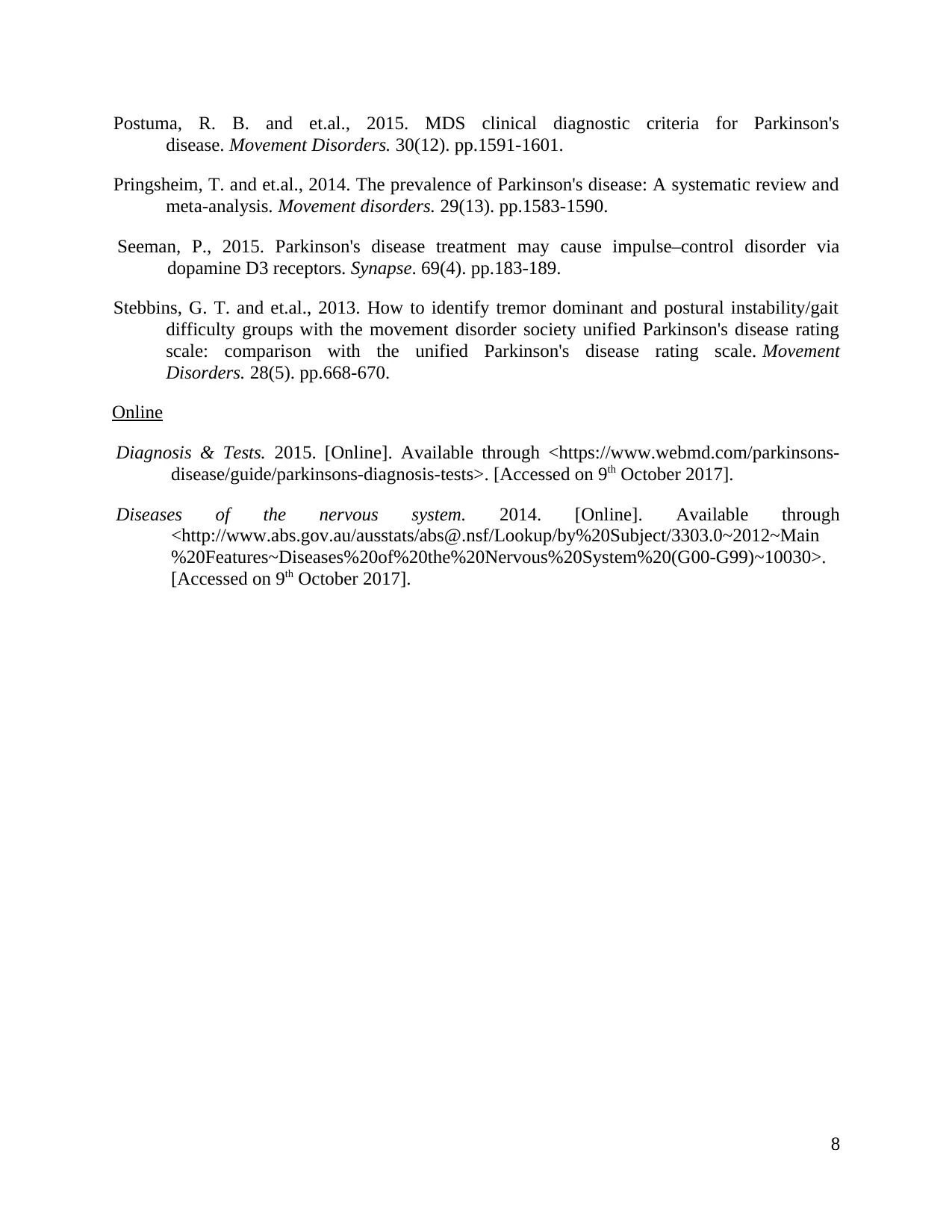
Postuma, R. B. and et.al., 2015. MDS clinical diagnostic criteria for Parkinson's
disease. Movement Disorders. 30(12). pp.1591-1601.
Pringsheim, T. and et.al., 2014. The prevalence of Parkinson's disease: A systematic review and
meta‐analysis. Movement disorders. 29(13). pp.1583-1590.
Seeman, P., 2015. Parkinson's disease treatment may cause impulse–control disorder via
dopamine D3 receptors. Synapse. 69(4). pp.183-189.
Stebbins, G. T. and et.al., 2013. How to identify tremor dominant and postural instability/gait
difficulty groups with the movement disorder society unified Parkinson's disease rating
scale: comparison with the unified Parkinson's disease rating scale. Movement
Disorders. 28(5). pp.668-670.
Online
Diagnosis & Tests. 2015. [Online]. Available through <https://www.webmd.com/parkinsons-
disease/guide/parkinsons-diagnosis-tests>. [Accessed on 9th October 2017].
Diseases of the nervous system. 2014. [Online]. Available through
<http://www.abs.gov.au/ausstats/abs@.nsf/Lookup/by%20Subject/3303.0~2012~Main
%20Features~Diseases%20of%20the%20Nervous%20System%20(G00-G99)~10030>.
[Accessed on 9th October 2017].
8
disease. Movement Disorders. 30(12). pp.1591-1601.
Pringsheim, T. and et.al., 2014. The prevalence of Parkinson's disease: A systematic review and
meta‐analysis. Movement disorders. 29(13). pp.1583-1590.
Seeman, P., 2015. Parkinson's disease treatment may cause impulse–control disorder via
dopamine D3 receptors. Synapse. 69(4). pp.183-189.
Stebbins, G. T. and et.al., 2013. How to identify tremor dominant and postural instability/gait
difficulty groups with the movement disorder society unified Parkinson's disease rating
scale: comparison with the unified Parkinson's disease rating scale. Movement
Disorders. 28(5). pp.668-670.
Online
Diagnosis & Tests. 2015. [Online]. Available through <https://www.webmd.com/parkinsons-
disease/guide/parkinsons-diagnosis-tests>. [Accessed on 9th October 2017].
Diseases of the nervous system. 2014. [Online]. Available through
<http://www.abs.gov.au/ausstats/abs@.nsf/Lookup/by%20Subject/3303.0~2012~Main
%20Features~Diseases%20of%20the%20Nervous%20System%20(G00-G99)~10030>.
[Accessed on 9th October 2017].
8
Paraphrase This Document
Need a fresh take? Get an instant paraphrase of this document with our AI Paraphraser
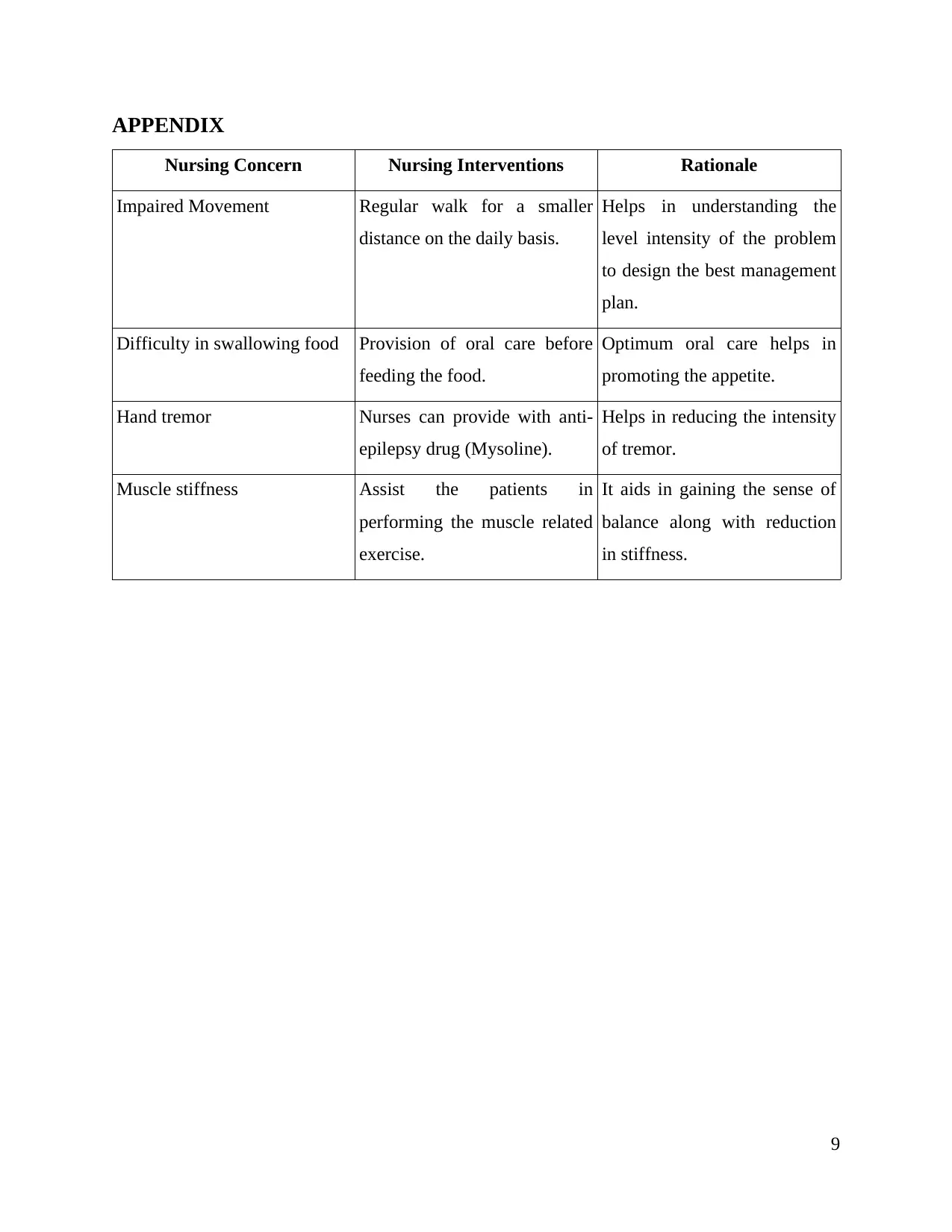
APPENDIX
Nursing Concern Nursing Interventions Rationale
Impaired Movement Regular walk for a smaller
distance on the daily basis.
Helps in understanding the
level intensity of the problem
to design the best management
plan.
Difficulty in swallowing food Provision of oral care before
feeding the food.
Optimum oral care helps in
promoting the appetite.
Hand tremor Nurses can provide with anti-
epilepsy drug (Mysoline).
Helps in reducing the intensity
of tremor.
Muscle stiffness Assist the patients in
performing the muscle related
exercise.
It aids in gaining the sense of
balance along with reduction
in stiffness.
9
Nursing Concern Nursing Interventions Rationale
Impaired Movement Regular walk for a smaller
distance on the daily basis.
Helps in understanding the
level intensity of the problem
to design the best management
plan.
Difficulty in swallowing food Provision of oral care before
feeding the food.
Optimum oral care helps in
promoting the appetite.
Hand tremor Nurses can provide with anti-
epilepsy drug (Mysoline).
Helps in reducing the intensity
of tremor.
Muscle stiffness Assist the patients in
performing the muscle related
exercise.
It aids in gaining the sense of
balance along with reduction
in stiffness.
9
1 out of 11
Related Documents
Your All-in-One AI-Powered Toolkit for Academic Success.
+13062052269
info@desklib.com
Available 24*7 on WhatsApp / Email
![[object Object]](/_next/static/media/star-bottom.7253800d.svg)
Unlock your academic potential
Copyright © 2020–2025 A2Z Services. All Rights Reserved. Developed and managed by ZUCOL.





